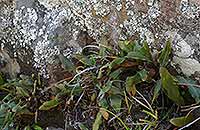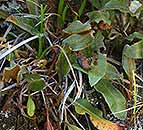Elaphoglossum deckenii (Kuhn) C. Chr.
Synonyms |
Acrostichum deckenii Kuhn |
|---|---|
Common name |
|
Description |
Rhizome short creeping, up to 2.5(-10) mm in diameter; rhizome scales 3-5 mm long, dark brown to black, shining, linear-lanceolate in outline, ciliate; phyllopodia distinct. Fronds clustered, erect or arching, firmly herbaceous, dimorphous. Sterile frond: 18-85 cm long, stipe up to 20 cm long, straw-coloured to brown, grooved, densely set with lanceolate, pale brown, ciliate scales; lamina up to 12-75 × 2-5 mm, narrowly elliptic to lanceolate in outline, apex tapering to a point, base wedge-shaped, margin entire, thinly set with ovate to linear-lanceolate, pale brown (under surface) to whitish (upper surface), ciliate, c. 3 mm long scales on both surfaces, costa prominent; veins obscured by scales, free, simple or once-forked, c. 1 mm apart, at c. 70° angle to costa; hydathodes absent. Fertile frond: stipe c. 16 cm long, covered with scales similar to the sterile frond; lamina up to 10-24 × 1-2 cm, linear-lanceolate in outline with the two sides conspicuously reflexed backwards, apex rounded to pointed, base wedge-shaped to truncate or rounded, set with ciliate scales similar to those on the sterile frond on the upper surface and along the midrib below; intersporangial scales absent; sori covering the whole undersurface of the lamina. |
Notes | Differs from E. kuhnii by having black rhizome scales. |
Derivation | deckenii: this fern was first collected in Tanzania by Baron Carl von Decken (1833-1865), a German explorer. |
Habitat | Moist montane forest and up to giant heath zone. |
Distribution worldwide | Africa, Madagascar, Comoro islands and Réunion. |
Distribution in Africa |
Dem. Republic of Congo, Ethiopia, Kenya, Malawi, Rwanda, Tanzania , Uganda, Zimbabwe. |
Growth form |
Epiphytic, lithophytic, terrestrial. |
Literature |
|

